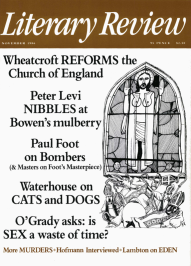Geoffrey Wheatcroft
Not Drowning Just Waving
The Church in Crisis
By Charles Moore, A N Wilson and Gavin Stamp
Hodder & Stoughton 224pp £6.95
When Henry VIII’s dynastic and leg-over considerations led him to break with Rome, he can have had no idea what an odd institution he was creating in the Church of England, or how much anguish he was storing up for generations of sensitive young Englishmen. Three of the more anguished, the editor of the Spectator, a well-known novelist and a distinguished architectural writer sharing the same ecclesiastical sympathies, have now turned their attention to (what a title) The Church in Crisis.
But is it? The picture they present is of a church in suspended animation or perhaps in the throes of disintegration, but no more in crisis now than for decades past. Their church is as odd as ever, if not odder. It is sui generis, for ‘it is generally but vaguely known that the Church of England is unique,’ as goes the first sentence of Mr Moore’s piece, from which you might not know that he is an excellent writer. How is it so?
In three essays, Mr Moore writes about the central organisation, which means the episcopal structure and his bugbear, the General Synod; Mr Wilson writes about the clergy; Mr Stamp about the parish and its buildings. There are also three voices: Mr Moore is irritable, Mr Stamp is mournful (as well

Sign Up to our newsletter
Receive free articles, highlights from the archive, news, details of prizes, and much more.@Lit_Review
Follow Literary Review on Twitter
Twitter Feed
Under its longest-serving editor, Graydon Carter, Vanity Fair was that rare thing – a New York society magazine that published serious journalism.
@PeterPeteryork looks at what Carter got right.
Peter York - Deluxe Editions
Peter York: Deluxe Editions - When the Going Was Good: An Editor’s Adventures During the Last Golden Age of Magazines by Graydon Carter
literaryreview.co.uk
Henry James returned to America in 1904 with three objectives: to see his brother William, to deliver a series of lectures on Balzac, and to gather material for a pair of books about modern America.
Peter Rose follows James out west.
Peter Rose - The Restless Analyst
Peter Rose: The Restless Analyst - Henry James Comes Home: Rediscovering America in the Gilded Age by Peter Brooks...
literaryreview.co.uk
Vladimir Putin served his apprenticeship in the KGB toward the end of the Cold War, a period during which Western societies were infiltrated by so-called 'illegals'.
Piers Brendon examines how the culture of Soviet spycraft shaped his thinking.
Piers Brendon - Tinker, Tailor, Sleeper, Troll
Piers Brendon: Tinker, Tailor, Sleeper, Troll - The Illegals: Russia’s Most Audacious Spies and the Plot to Infiltrate the West by Shaun Walker
literaryreview.co.uk